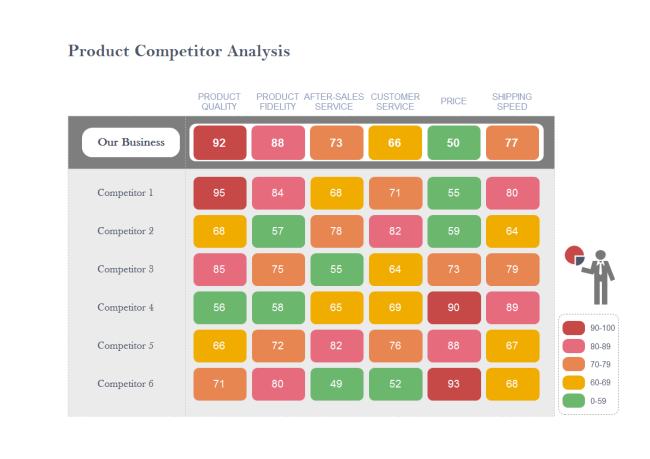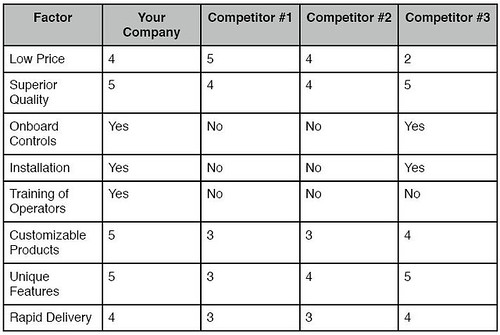is a way of evaluating how well your business and its products or services are performing
Competitive analysis
A typical competitor table contains the following:


Competitive analysis
Competitive analysis means: “Identifying your competitors and evaluating their strategies to determine their strengths and weaknesses relative to those of your own product or service.”
For anyone starting to design a new product, it is critical to make sure it has good market fit. The product also has to have a compelling competitive advantage over others in the marketplace.
setting realistic goals
Try to determine what you hope to achieve through your competitor product analysis.
By setting clear SMART marketing goals, you and your team will know exactly what you are working towards.
Identify your competitors
– Direct competitors: These competitors are in the same category that offer similar products or services to similar target markets.
– Substitute or indirect competitors: Indirect competitors are businesses in the same category that sell different products or services to solve the same problem.
– Similar, phantom or replacement competitors: A replacement competitor offers an alternative to the product or service that you offer. You both seek to solve the same pain points, but the means are different.
SWOT analysis
An acronym for “Strengths, Weaknesses, Threats, and Opportunities”, a SWOT analysis is a high-level strategic planning technique that helps companies, both from an internal and external viewpoint. . . This analysis revolves around aspects such as finance, customer service, learning, growth, marketing, etc.
Benchmark your products
Benchmarking is an ongoing process in which you measure your products, services,
business processes or ways of working
against other comparable examples.
By comparing and rating your offer, methods and outcomes, and in the process gathering
insight into best practice, you aim to improve your own business performance.

Understand/Research the Competition
-
Every company or product begins with an intention to solve a pressing problem. Consequently, a considerable amount of market and user research is carried out. The companies that succeed (and are able to sustain that success) are those which constantly refine and improve their offerings and overall service—in other words, their product’s UX.
Doing a deep dive and understanding the competition is something that helps drive a better design strategy or your product or client. An important competitive analysis best practice is to discover three things: the why, the what, and the how behind your competitors’ products.a better design strategy fa better design strategy
-
List of competitors.
- Who their target market is?
- What makes them, their products or services unique?
Stay Updated with Current Industry Trends
Studying your competitors gives you an idea about what’s trending in your industry. Thus, you can use this information to shape your campaigns, products, and services. Keeping up with trends is vital to offer what your target audience is looking for instead of continuing the same old pattern that has become obsolete and possibly driving your customers away.
Evaluate their marketing strategies
- Tracking their PR presence like articles on the web and newspapers will help you understand their media interests and improve your PR strategy.
- Similarly, tracking who covers your competitors like bloggers, journalists, influencers, and other content creators on their blogs, websites, or YouTube channels will help you discover your possibilities. You can use the insights to build a long list of all those who can tell your story and feature your products and services to give you wider recognition among your targeted audience.
- Watch out for new products or services your competitors launch and how much impact they are making on their customers. Chase the public reactions to understand whether their new move was successful or not. You can use this insight to learn how to pull a similar stunt even better.
- Check Their Website: website is the first place our customers will land and check out our offerings and how your products/services can benefit them. If you represent it well, they may consider your offerings or become your regular reader. So, regularly getting a sneak peek at your competitors’ websites will help you understand the recent changes, news, events, and product launches. It will help you understand how they are presenting information and how user-friendly their site is.
SEO strategy: Examine your competitors’ SEO strategies by evaluating things like their title tags, meta descriptions, ranking keywords and page ranks.
Paid channels: Use tools to review your competitors’ methods for promoting themselves and what keywords they’re targeting.
Email campaigns: Sign up for your competitors’ email lists, and compare their email campaign strategies with yours. Evaluate the frequency, contents and appearance of its emails compared to yours.
Social media: Follow your competitor on its social media channels. Analyze which channels it uses and how it uses them, such as what kind of messaging it uses about its products.
Use Their Products
You can establish a basic understanding about the competition by studying their online/offline presence. However, if you want to really understand their service design, you will need to actually use a competitor’s product.
Here is how:
- If available, register for a free trial (or sign up for a brief period).
- Use the competitor’s product and analyze how their user journeys/task flows are designed . Draw an approximate user journey map (for example, completing a purchase). How is the UX?
- Examine how easy or frustrating it is to complete a task.
- How well are they solving a problem? Could it be improved?
- Interact with the competitor’s customer service — via email, Twitter, Facebook, phone calls, etc. and make note of how they handle such interactions.
- How does the general discoverability of your competitor’s product/service rank? Their marketing and growth strategy? Analyze the competitor’s SEO, Alexa rankings, and social presence.
- What is the competitor’s pricing strategy? Sometimes, even if your product’s features match the competitor’s, you can gain an edge by being smart about your pricing strategy.
Pinpoint UX Issues with Competitors’ Products
-
Every platform or a product is designed with a certain type of user/target demographic in mind. It typically goes through many iterations based on various post-launch analytics, user research, and testing. Nevertheless, some product designs are based purely on assumptions, hypotheses, and the opinion of stakeholders, and therefore often turns out to be less than perfect. We can learn from others’ mistakes by identifying a competitor’s problems, or what remains unsolved with their product’s overall UX.
Here are some ideas that will help identify UX problems:
- Study and research various task flows and aspects of the competitor’s product, like the user onboarding process. How many steps does it involve? Is it easy, or is it too convoluted and takes too long?
- Does the competitor’s product pass basic usability, heuristic guidelines, and interaction design principles?
- Look at how they optimized user flows. Can they be improved? For example, if it takes someone using your competitor’s product five steps and more than a minute to complete a purchase, see how it can be made faster.
- Identify any critical features the competitors may have missed or, if you are unable to find anything, what overall improvements can be made.
- How well have your competitors designed their service? What is the language they use in their email communications? On the system?
- How their information architecture is designed? Study their sitemap(s).
Identify the Visual Design & performing content
- Check their top-performing content: Evaluate your competitors’ best-performing content like blogs, articles, etc., through social shares and engagement metrics. You can learn what keywords they are ranking for, topics their audience engages with, article length and quality, and more.
- Discover top keywords: choosing the right keywords can help you change your SEO and content strategy dramatically. You can use tools to monitor your competitors’ keywords, search volume data, competition for different keywords, etc.
- Attend their webinars: Webinars are an excellent form of content marketing to engage your audience, position your brand, and establish your knowledge on a specific topic your audience wants to know about. So, attend your competitors’ webinars to learn how they are doing it, whether you are a new or a seasoned brand. It will help gauge your audience’s interests, reactions, and engagement rates.
- Find out how a competitor’s landing page is structured visually and how they persuade users to sign up and purchase their offerings.
- What color scheme are they using? What could be the reason behind their color decisions?
- Are the calls to action clear?
- Does the platform work well on mobile or tablet devices?
- Collect screenshots of various screens from your competitor’s platform, study them, and write up a report on all that’s good as well as all that’s wrong with it.
Blue Ocean Strategy
An effective blue ocean strategy means identifying the right market opportunity, reaching the market before your competitors making them irrelevant, and generating demand that does not currently exist. You have to bear in mind that the marketplace has a broader potential that has not yet been explored. Many blue oceans are created by extending established industry boundaries from within the red oceans.
When we say that we need our goals to be realistic, we mean they must be achieved within a specific time span. So here are some essential pointers to follow after goal-setting:
Google search First
Do some reporting with
- SpyFu: “A great resource to research what keywords and Adwords our competitors are buying,” says Mohnot.
- Google Trends: For Mohnot, it’s helpful when he wants “to stay on top of the latest in [his] industry, comparing [his company] to others, and seeing where people who come to [his] site go.”
- Google Alerts: “We keep alert for ourselves, but also for all of our competitors to know what they are up to,” says Mohnot. (P.S. Don’t forget to set up an alert on your own company to see if anyone else is talking about you.)
-
Trade associations and advocacy groups,” says Becky Sheetz-Runkle, author of Sun Tzu for Women: The Art of War for Winning in Business. “These organizations are doing research and studies that evaluate the people who are and should be your competitors.
- Other resources you can use to dig up information on your competitors include: Alexa, Compete, Keyword Spy, Hoovers, and ReferenceUSA.
We can use insights gleaned from a competitive intelligence software such as Contify.
Check in with your suppliers. If you work in an industry where you share the same suppliers as your competitors, it could pay to ask them some simple questions. “Talk to your suppliers and spend time getting to know them,”
Conduct a survey
- Identifying market gaps. When you do competitive research, you’re analyzing the strengths and weaknesses of your competitors. You’ll often find that, by looking at the data, there is a segment of the population that is being underserved. This could put your business in a unique position to reach those customers.
- Planning for the future. The most important byproduct of competitive research is that it will help you create a strategic plan for your business. This includes things like improving your product or service, using more strategic pricing strategies, and improving the promotion of your products.
Prepare a Competitor ANALYSIS REPORT
The competitive analysis involves identifying your direct and indirect competitors using research to reveal their strengths and weaknesses in relation to your own. In this guide, we’ll outline how to do a competitive analysis and explain how you can use this marketing strategy to improve your business.

A typical competitor analysis matrix contains the following:
Here is a list of a few things which should be included in a competitor analysis report:
An in-depth analysis of each of the identified competitors’ products.
Screenshots along with annotations explaining the specifics of each feature/UX flow.
Feature list and/or approximate sitemap of each competitor’s platform/product.
Strengths and areas of improvement for each of the analyzed products.
Competitor analysis matrix —A table which contains a column for features of a product and separate columns for each of the product.
- Here is an example of how a competitor analysis matrix can be structured:

A competitive matrix is a type of competitive analysis tool, which helps you learn about your market segment and identify opportunities.
There are different types of competitive matrices, but most of them are simple charts wherein you list the main features and benefits of your product or service. On the top row, you list your company and the names of your competitors and fill in the chart with the appropriate information for each company. However, they can also be complex graphs with x and y axes representing unique positioning within a market segment. Competitive matrices can be used for any form of competitive analysis, including SWOT analysis, features and benefits analysis, content marketing strategies, review tracking, and much more.
